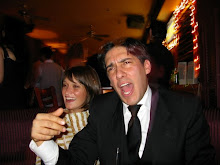
The Sticky Memory (of Myelin)
A lover once spontaneously told me something that has stuck with me ever since. She said, “I like parts.”
Parts are important.
For not only do parts make a whole, but apparently there’s memory in them parts.
I realized how true this is this morning when I tried to tie my tie (ma cravate, mi corbata).
I had tied my tie at least a thousand times before—years of this way-then-that way, without a single hitching thought in between, a seamless labyrinth of overlay, cross, inward-tuck, fold over, an under-out-and in, a slight pull, tap for the divot and a good tug again. Easy, piece of cake. Years of working at a conservative corporate office had quintessentially made the task second nature for me.
That is, until I lost my thumb.
Or rather, temporarily lost the use of it.
For this morning, for a very long minute, I stood in a startled state of sudden confusion—befuddled, bemused and dumbfounded—for I simply could not remember how to tie my tie. Without the use of my thumb, I literally, for a vexing mind-boggling moment, was at a complete loss for something that had become no harder than brushing my teeth.
After taking a deep breath and recomposing myself, I was finally able to do the loop-the-loop, a simple act of vanity that I had apparently taken for granted, because I had vainly forgotten that I had not always been able to do it.
It was then that it dawned on me that there must be memory in my thumb. That without it there was a synaptic disconnect of some odd sort.
I had long heard about the phenomenon of the phantom limb—where amputees feel and behave as if there limb is still there because there are still nerve connections from the brain to the joint that once connected the missing part.
But this morning’s vexation was almost a reversal of that kind of experience, because, albeit temporarily inactive, the limb (digit actually) was still there, but the memory of an action it once helped implement —wasn’t.
A long time ago I read that studies have been done that conclude that physically participating in something helps create a better memory of that activity. For example, it has been inferred that since drivers are physically involved they tend to remember the routes they have driven substantially better than their passengers.
Hence, apart from the fact that we share some of the most beautiful, tender, inspiring, and happiest moments of our lives, I surmise that this is also why we remember our lovers so well. The physical interaction creates a sticky memory that adheres to neurons, our nerve cells, much like a sheath and helps us make the connections between our minds and our bodies, especially when we need, want and desire to recollect the special moments.
Scientists call this gluttonous coating—myelin, which is actually composed of approximately 80% lipid fat and 20% protein.
Although myelin was discovered over 100 years ago by Louis-Antoine Ranvier in 1878, it is the 1992 movie Lorenzo’s Oil (with Nick Nolte and Susan Sarandon) that created some of the greatest public awareness about its vital importance to our nervous system and basic motor functioning.
The film is the real-life story about two pro-active parents who set out to turn over common notions in medical science and discover a treatment for their son’s “demyelination,” which is essentially the erosion of the myelin that coats the axons (the tentacles) that sprawl from the center of nerve cells to connect with one another and ultimately create our motor skills, memories and otherwise related human abilities and agilities. Without the myelin, nerve impulses are either slowed down or completely stopped in mid-pulse. Demyelination is primarily caused by acquired diseases like multiple sclerosis, hereditary neuro-degenerative disorders such as the leukodystrophies, or metal (esp. mercury) poisoning.
Although doctors had given Lorenzo two years to live after his diagnosis in 1984 with adrenoleukodystrophy (ALD), the treatment that his parents discovered allowed him to survive, and now he is 25 years old.
Since then scientists have concluded that extraordinary athletes likely possess globs of myelin, because the thicker the coating, the stronger the connection and the quicker the reaction time.
Dr. Douglas Field, director of he Laboratory of Developmental Neurobiology at the National Institute of Health in Bethesda, Maryland, recently said in a recent article* on the discovery “I would predict that South Korean women golfers have more myelin, on average, than players from other countries…They’ve got more in the right parts of the brain and for the right muscle groups, and that’s what allows them to optimize their circuitry.”
(*How to Build a Prodigy: The Super Athlete Formula, Daniel Coyle, New York Times Sports Magazine, March 2007)
Myelin not only serves to prevent the electrical current from leaving the axon, but also increases resistance of the electircal impulse across the cell membrane by a factor of 5,000. In other words, the branches of our nerve cells that are coated (because not all neurons are sheated) deliver the message exponentially faster than their naked and unprotected brethren.
So remember, Use Protection! (Oops, wrong musing)
Anyway, researchers have also concluded that myelin is essentially created via lots of practice. Daniel Coyle, author of the previously quoted article, writes, “the little sausages of myelin get thicker when the nerve is repeatedly stimulated. The thicker the myelin gets, the better it insulates and the faster and more accurately the signals travel.”
Thus, not only does practice make perfect—it makes a lot of myelin.
Hence, perhaps it is not a far-fetch, a wonderfully slow and sinewy stretch, to say that when lovers come together they are learning to be better lovers, especially as they learn to react in synch with one another, as they learn to deftly intertwine, gracefully undulate and gradually meld as one.
Maybe than, that is why it hurts so much to be broken apart sometimes, to have to leave your lover after a prefect night, an afternoon delight or wonderfully whimsical rendezvous; the memories of which lead to the wallowing reminisces; the pangs and the yearning; the painfully insatiable desire, as well as the obsessive impulse to see each other again.
Shakespeare got it all too right over 400 years ago when he had Juliet coo to Romeo—Parting is such sweet sorrow.
adieu, adios, until i write again,
lorenzo
“Haphaestus, with his instruments, came to a pair lying side by side and said to them, 'Do you desire to be wholly one; always day and night to be in one another's company? For if this is what you desire, I am ready to melt you into one and let you grow together, so that being two you shall become one ~ there is not a man of them who when he heard the proposal would deny or would not acknowledge that this meeting and melting into one another, this becoming one instead of two, was the very expression of his ancient need. And the reason is that human nature was originally one and we were a whole, and the desire and pursuit of the whole is called love.” —Symposium, Plato—




No comments:
Post a Comment